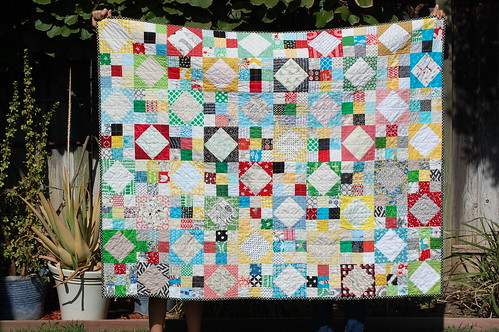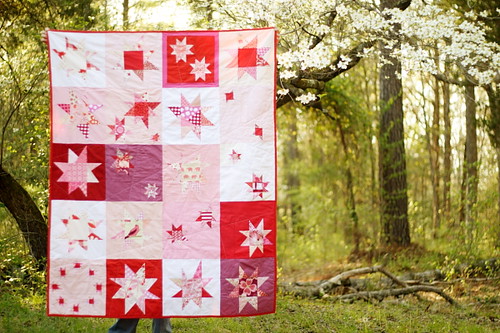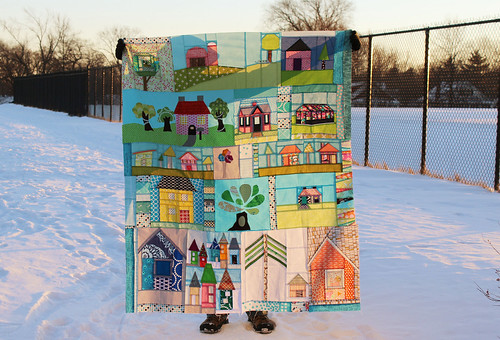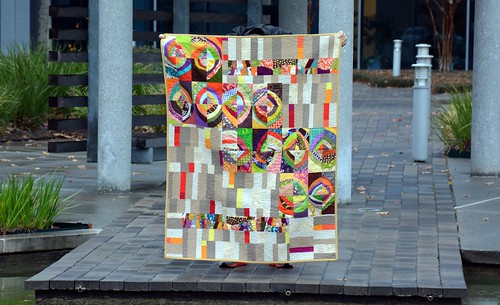designing Collaborative Quilts
Thanks for your feedback on yesterday's improv blocks! There's a good, healthy variety on which ones we like better. That's what makes the world go round! And I do hope you guys try your hand at them sometime. Scraps are so forgiving, aren't they? Just sew them together and see what happens!
Today I'm thinking about bee quilts since my turn to lead the Love circle quilt is coming in March. In the past 3 1/2 years (!!) that I've been a part of Love circle, we've made oodles of quilts for Wrap Them in Love, and I'm proud of them all. As I think over the ways that they're each unique, I also spot some patterns. I can roughly boil it down to 3 different approaches for leading bee quilts (all illustrated with Love Circle quilts). Today I'm wondering... what kind of bee quilt am I in the mood to make?
::Repeating Block Grid::
The most simple and obvious collaborative quilt is composed of a specific quilt block sewn up in a standard grid layout. The leader will often choose a very specific block, such as the Sawtooth Star or Log Cabin, to finish at a particular size (probably 12"). Each bee member can make one or more blocks, as necessary to bring the quilt to an ideal size.
One variation of this approach is to ask for a block theme, such as stars, allowing members to choose a favorite star block construction. For variety, quilters sometimes sash the blocks or set them on point.
Another variation is the strip quilt, where all members make a particular patchwork strip in a certain width. Like blocks, the strips will be sewn together in predictable rows.
Repeating blocks make beautiful, classic quilts or even unexpected ones, depending on the chosen block. This design style is easy on the leader (straightforward assembly) and comfortable for members (they know exactly what to sew).
::Interpretive Blocks:
Another style of collaborative quilting relies heavily on each member's artistic contribution. Here the lead quilter will request blocks in a theme that is very open-ended, such as "houses and trees." If members can use all kinds of piecing styles (applique, paper piecing, wonky improv, etc.) and the theme is broad, bee mates will create really unique interpretations.
The leader may ask blocks to finish a particular size or leave the size open-ended as well. If the size is undefined, she'll have to fill in between blocks with negative space or creative piecing of her own. I think that blocks relying heavily on improv usually feel interpetive.
This type of bee quilt tends to energize! Each feels that her artistic vision is valued. On the other hand if you're uninspired by the theme, interpretive blocks can be paralizing. What to sew? I think it works well for uninspired members to copy the style of another bee mate (so long as she feels that would be welcome). This releases that sense of pressure and actually creates some helpful unity in an otherwise diverse work.
Intreptive block quilts are fascinating quilts. They can be spectacularly successful! But it's true that once in a while a leader will receive blocks that she really struggles to bring together. It's a style that's exciting and challenging for all involved.
::Design Seeds::
I've notice a whole other category of bee quilts where the bee blocks are like seeds. In the hands of the lead quilter, blocks blossom into an unexpected and complex design. The lead quilter might ask for specific or interpretive blocks. The point is that what results is not something her bee mates could have anticipated. The assembly is a very creative process!
For example, the lead quilter might place simple, traditional blocks in a really unusual layout with lots of negative space. Maybe she partly disassembles or even cuts blocks, using them like raw material for a more complex design. Other times the lead quilter takes smallish blocks, which don't cover much space, and adds a bunch of her own design details.
I love it when a bee mate surprises me with a finished work oozing with her unique design style. I personally don't mind at all if my blocks are like seeds, which others may need to alter to fit a vision. I hope that others feel the same? Members probably feel less inspired when they can't see where the leader is going, but hopefully the surprise finish makes up for that! This style demands much more of the lead quilter, obviously. I think many times it "happens" more than is planned ahead.
So, what kind of bee quilt am I in the mood to make? I think I want to do a "design seeds" kind of work that calls for open-ended blocks from my bee mates. My last few bee quilts were repeating block styles, so I'm ready to shake things up. I've been feeling very improv lately! I guess my first step will be to create an inspirational block of my own.
Mmmm... could be a lovely weekend.
Today I'm thinking about bee quilts since my turn to lead the Love circle quilt is coming in March. In the past 3 1/2 years (!!) that I've been a part of Love circle, we've made oodles of quilts for Wrap Them in Love, and I'm proud of them all. As I think over the ways that they're each unique, I also spot some patterns. I can roughly boil it down to 3 different approaches for leading bee quilts (all illustrated with Love Circle quilts). Today I'm wondering... what kind of bee quilt am I in the mood to make?
::Repeating Block Grid::
The most simple and obvious collaborative quilt is composed of a specific quilt block sewn up in a standard grid layout. The leader will often choose a very specific block, such as the Sawtooth Star or Log Cabin, to finish at a particular size (probably 12"). Each bee member can make one or more blocks, as necessary to bring the quilt to an ideal size.
 |
| Goose Creek by Deborah |
One variation of this approach is to ask for a block theme, such as stars, allowing members to choose a favorite star block construction. For variety, quilters sometimes sash the blocks or set them on point.
 |
| Love in Wonky Stars by me |
Another variation is the strip quilt, where all members make a particular patchwork strip in a certain width. Like blocks, the strips will be sewn together in predictable rows.
 |
| Bits and Blocks by Ara Jane |
Repeating blocks make beautiful, classic quilts or even unexpected ones, depending on the chosen block. This design style is easy on the leader (straightforward assembly) and comfortable for members (they know exactly what to sew).
::Interpretive Blocks:
Another style of collaborative quilting relies heavily on each member's artistic contribution. Here the lead quilter will request blocks in a theme that is very open-ended, such as "houses and trees." If members can use all kinds of piecing styles (applique, paper piecing, wonky improv, etc.) and the theme is broad, bee mates will create really unique interpretations.
 |
| Happy Houses by Natalie |
The leader may ask blocks to finish a particular size or leave the size open-ended as well. If the size is undefined, she'll have to fill in between blocks with negative space or creative piecing of her own. I think that blocks relying heavily on improv usually feel interpetive.
 |
| by Oh, Fransson! |
This type of bee quilt tends to energize! Each feels that her artistic vision is valued. On the other hand if you're uninspired by the theme, interpretive blocks can be paralizing. What to sew? I think it works well for uninspired members to copy the style of another bee mate (so long as she feels that would be welcome). This releases that sense of pressure and actually creates some helpful unity in an otherwise diverse work.
 |
| Wintry Shoo-fly by Jacey |
Intreptive block quilts are fascinating quilts. They can be spectacularly successful! But it's true that once in a while a leader will receive blocks that she really struggles to bring together. It's a style that's exciting and challenging for all involved.
::Design Seeds::
I've notice a whole other category of bee quilts where the bee blocks are like seeds. In the hands of the lead quilter, blocks blossom into an unexpected and complex design. The lead quilter might ask for specific or interpretive blocks. The point is that what results is not something her bee mates could have anticipated. The assembly is a very creative process!
 |
| Geodes by Jaceycraft |
For example, the lead quilter might place simple, traditional blocks in a really unusual layout with lots of negative space. Maybe she partly disassembles or even cuts blocks, using them like raw material for a more complex design. Other times the lead quilter takes smallish blocks, which don't cover much space, and adds a bunch of her own design details.
 |
| Love in Polaroids by me |
I love it when a bee mate surprises me with a finished work oozing with her unique design style. I personally don't mind at all if my blocks are like seeds, which others may need to alter to fit a vision. I hope that others feel the same? Members probably feel less inspired when they can't see where the leader is going, but hopefully the surprise finish makes up for that! This style demands much more of the lead quilter, obviously. I think many times it "happens" more than is planned ahead.
So, what kind of bee quilt am I in the mood to make? I think I want to do a "design seeds" kind of work that calls for open-ended blocks from my bee mates. My last few bee quilts were repeating block styles, so I'm ready to shake things up. I've been feeling very improv lately! I guess my first step will be to create an inspirational block of my own.
Mmmm... could be a lovely weekend.